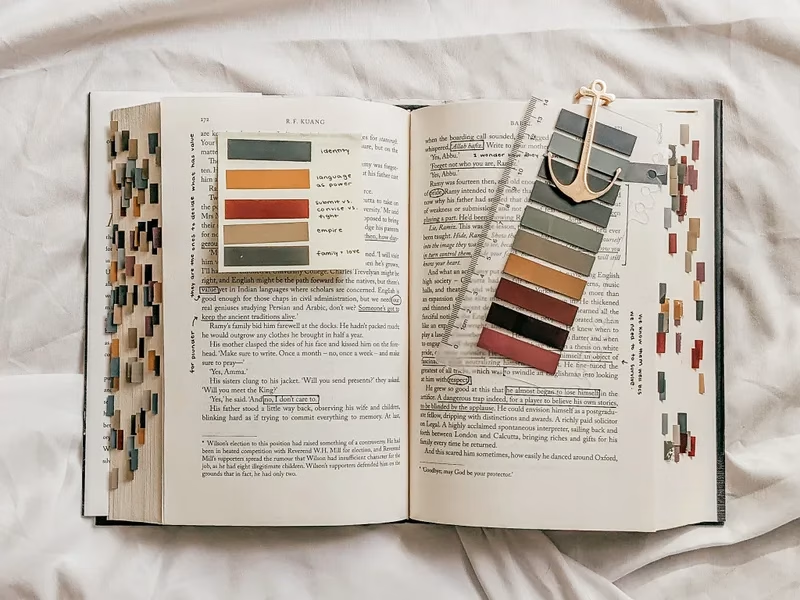In the world of reading, there are two distinct types of book lovers: those who would rather die than dog-ear a page and keep their beloved books as pristine as possible, and those whose volumes are filled with life—creased corners, underlined passages, and personal notes in the margins. Rarely do these two groups mingle, let alone borrow each other’s books. However, a new wave of readers is bringing both philosophies together, breathing new life into the age-old practice of marginalia and turning their reading experiences into aesthetically pleasing artifacts.
One TikToker recently shared their surprise upon discovering colorful sticky tabs sprouting from novels in a viral video. “What is this?” they exclaimed. “This looks like homework! But I also love office supplies.”
Within the vibrant BookTok and Bookstagram communities—where users share reviews and memes about their reading experiences—there are niche groups dedicated solely to the art of annotation and “tabbing” books. The intensity of this annotation varies; some readers employ intricate color-coding systems (using pink for romantic moments and blue for foreshadowing), while others focus on making their notes visually appealing. Readers scribble reactions in the margins to mark unforgettable moments, or draw hearts around particularly steamy passages. For many, annotating is as integral to their reading journey as sharing shelfies or writing reviews.
Marcela, a Bookstagrammer from Melbourne, began her annotating adventure last year after immersing herself in various fandoms for over a decade. Her journey into beautiful, detailed note-taking developed through her engagement with “studygram” communities and attractive stationery.
“Before I even knew I was ‘annotating,’ I was writing little reactions in the margins to capture my thoughts while experiencing a story,” Marcela recalls. She now uses color-coded tabs and pens along with her reading journals. “I focus on books that I know I’ll revisit—like the Throne of Glass series by Sarah J. Maas.”
“Annotating has deepened my appreciation for the intricate world-building and character development,” she explains. “It allows me to see my evolving opinions on characters and to revisit my initial predictions about the plot.”
The prominent genres within the annotating community are romance and romantasy, largely thanks to the rise of popular authors like Emily Henry and Ali Hazelwood. This newfound popularity has helped shake off much of the stigma that once surrounded romance novels, allowing die-hard fans to explore ways to showcase their love for these narratives.
Maria McAlister, a scholar in the field, notes, “This community is still discovering how to publicly embrace romance literature, making the act of reading an object of genuine affection. This is evident in how fans cherish their annotated copies—by personalizing the text, they create a treasured memento of their reading experiences.”
As McAlister points out, recent trends signify a passionate connection between readers and their books, allowing them to retrace their first encounters with stories. It’s a way to engage with literature that can evoke powerful emotions—much like the memories one has while reading a poignant book.
Annotation has also created new avenues for connection among readers. Some BookTokkers produce beautifully annotated copies of their friends’ favorite books as gifts, adding personal touches in the margins. For some, the act of reading becomes a way to preserve the memory of loved ones; one reader treasures her late mother’s notes in her history and poetry books. Others seek out annotated second-hand books to connect with previous readers or even the authors themselves.
In a similar vein, renowned author Ann Patchett released an annotated version of her novel, Bel Canto, which she noted might not be suited for first-time readers due to its “constant interruptions” and minor spoilers. Yet, through the annotation process, she discovered new patterns in her writing that she hadn’t been aware of at first.
Like McAlister, though I annotate my academic readings, I sometimes find myself so absorbed in a narrative that I neglect to leave notes for fun. However, this week I made a conscious effort to annotate a biography I had been putting off, and I quickly found myself jotting down side comments like I was sharing juicy gossip with a friend.
If annotating feels a bit like homework, it’s worth noting that it can enrich the reading experience. The few extra seconds it takes to underline or scribble a reaction allows you to savor the moment just a little longer.













